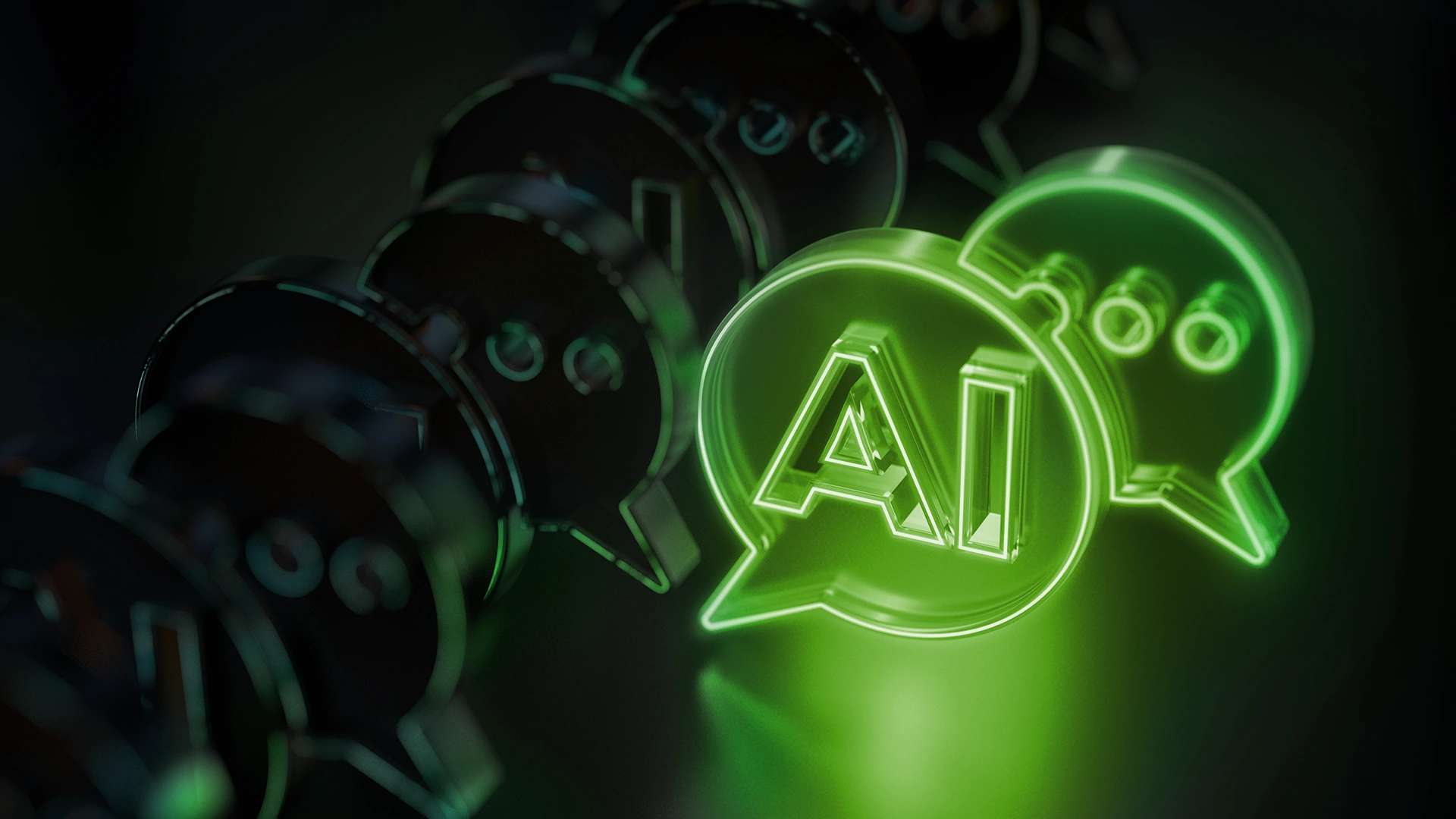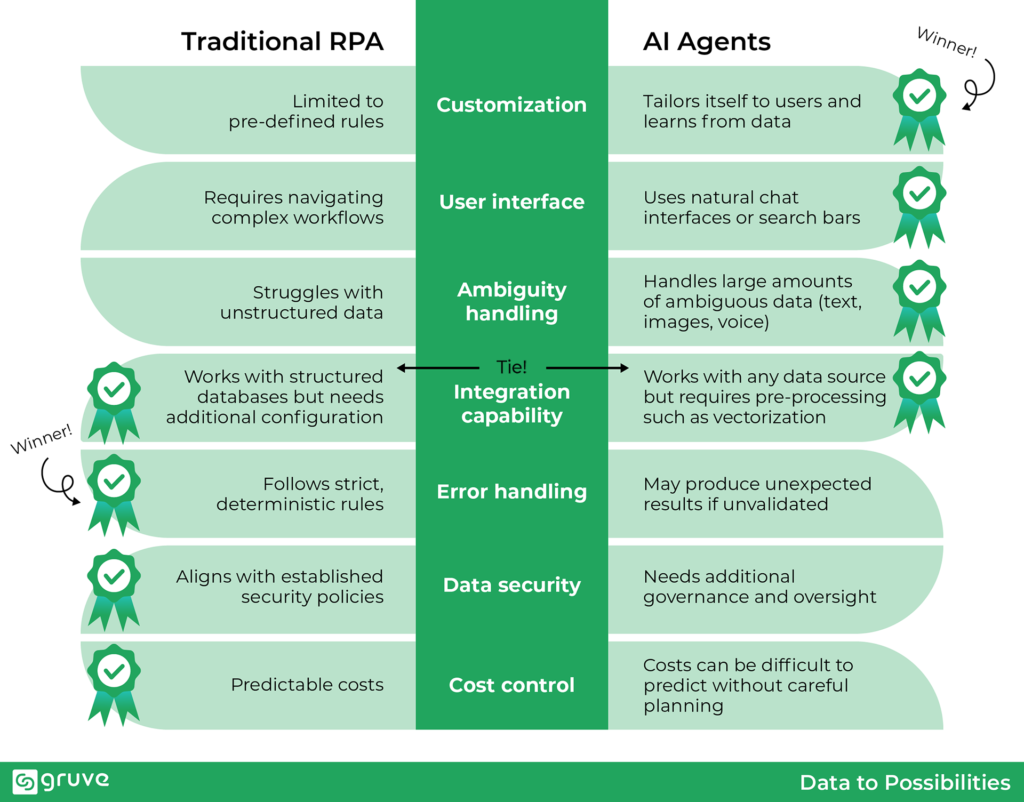Are AI agents replacing traditional enterprise software? Learn how AI and RPA work together for smarter enterprise automation.
For years, enterprise automation has relied on structured, rule-based systems powered by RPA (Robotic Process Automation), such as financial platforms, HR systems, CRMs (Customer Relationship Management), and IT service tools. These technologies handle critical business functions and ensure businesses function smoothly.
But now, AI agents are disrupting the automation landscape. Agents offer smarter, more adaptive automation that can analyze data in real-time, predict outcomes, and even assist in decision-making.
This evolution raises a key question: Are AI agents truly as capable as they seem? Does their rise signal the end of traditional RPA? Let’s take a closer look.
AI Agents vs. Traditional RPA: What’s the Difference?
Traditional enterprise applications are, at their core, rule-based systems. They follow predefined workflows and require structured data and human input for decision-making. Think SAP ERP managing supply chains with military-grade precision or Salesforce CRM tracking each stage of the sales pipeline.
AI agents, on the other hand, can plan and execute actions based on dynamic context without relying on hard rules. AI agents bring intelligent reasoning, real-time analysis, and decision-making capabilities.
For example, Salesforce Agentforce allows sales reps to generate sales pitches, recommend products, and resolve customer issues automatically, almost like a personal assistant built into the CRM. (Want to explore how AI can enhance customer experience? Check out our CX solutions.
Take Glean as another example. Glean is a leader in enterprise AI designed to understand, automate, and augment the way people work. Recently, it introduced an AI agent platform that allows users to build custom workflows, from streamlining HR inquiries to conducting engineering postmortems—all with just a few clicks and no coding required. (Read here to learn about how Gruve partners with Glean.)
Are AI Agents Replacing RPA?
So, what use cases are best suited for AI agents? And where does traditional RPA still excel? While AI agents seem powerful, they are not mature enough to cover all business needs, especially in areas requiring high accuracy and secure execution. Here’s a side-by-side comparison:
Takeaway: AI does not replace traditional RPA. The key is knowing where to use AI agents and where to stick with rule-based automation.
How to Ensure AI Agents Are Deployed Effectively
To get the most out of AI agents while minimizing risks, enterprises must focus on reliability, security, transparency, data quality, and performance. Here’s how:
Keep Humans in the Loop (HITL)
Today’s AI still makes mistakes, especially in complex scenarios or edge cases. Instead of fully automating critical processes, businesses should integrate human oversight at key checkpoints to review AI-generated outputs and handle exceptions. This approach not only reduces errors and compliance risks but also helps build trust in AI tools before scaling it across the organization managing AI agents.
Secure AI Agents Before They Become a Risk
AI-powered automation introduces new security challenges that traditional enterprise applications and RPA don’t face, such as data poisoning attacks (where malicious inputs corrupt AI decisions) and adversarial manipulation (tricking AI into misclassifying data). Before AI gets out of control, companies must continuously monitor deployment mythologies and enforce strict access controls.
Make AI Transparent
AI often feels like a black box, and when multiple agents are involved in a process, understanding their decisions becomes even harder. Companies should build tools and pipelines to track what data goes in, what comes out, and why certain decisions are made. This ensures AI-driven actions remain explainable and auditable.
Use Clean, Up-to-Date Data
AI is only as good as the data it learns from. If the source data is outdated or biased, AI agents can make poor decisions. Enterprises must establish robust data pipelines and governance policies to prevent low-quality inputs from degrading performance.
Watch out for Performance and Cost
AI agents can be expensive to run and slow to respond if not optimized. Keep an eye on infrastructure costs, fine-tune deployments, and use cost-efficient AI models and inference pipelines to avoid unnecessary spending.
Hybrid Models Are the Future

The best approach is not choosing AI over RPA. It’s using both. Hybrid automation models allow businesses to combine AI’s adaptability with RPA’s structured execution to maximize efficiency. Connect AI and RPA via an orchestration layer to create smooth handoffs between AI and RPA. For example, AI can classify and extract data from documents, but RPA must validate and process it within predefined compliance rules.
Looking Ahead
AI agents are changing the way businesses automate, but they are not a one-size-fits-all replacement for traditional enterprise applications. The smartest organizations will be those that blend AI’s intelligence with RPA’s reliability to achieve a scalable, future-proof automation strategy.
Ready to future-proof your automation? Talk to our team today.
FAQ
1. Are AI agents replacing traditional RPA?
No. Agents excel at judgment and unstructured tasks; RPA remains best for deterministic, compliance-critical, high-volume workflows. The winning pattern is hybrid.
2. When should I use an AI agent vs. RPA?
Use agents for variable processes (CX triage, knowledge lookup, intent classification, case summarization). Use RPA for stable, rule-based steps (data entry, reconciliations, approvals under fixed rules).
3. How do I deploy AI agents safely?
Keep humans-in-the-loop at key checkpoints, enforce least-privilege access, log every action, and monitor for prompt/data poisoning or adversarial inputs before scaling.
4. What improves accuracy, speed, and cost?
Ground agents on clean, current data; add evals and guardrails; use caching, batching, and smaller models where possible; set SLOs for latency and track cost per task.
5. How do AI and RPA work together in a hybrid model?
Let AI interpret/decide (classify, extract, route); hand off to RPA to execute in systems-of-record under rules. Measure ROI via cycle time, error rate, SLA adherence, and cost per transaction.





